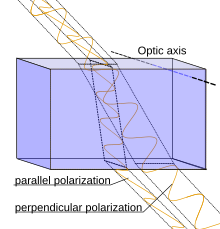
Back Dubbelbreking Afrikaans انكسار مزدوج Arabic Двайное праменепраламленне Byelorussian Двойно лъчепречупване Bulgarian বায়ারফ্রিঞ্জেন্স Bengali/Bangla Dvolomnost BS Birefringència Catalan Dobbeltbrydning Danish Doppelbrechung German Duobla refrakto Esperanto


Birefringence means double refraction. It is the optical property of a material having a refractive index that depends on the polarization and propagation direction of light.[1] These optically anisotropic materials are described as birefringent or birefractive. The birefringence is often quantified as the maximum difference between refractive indices exhibited by the material. Crystals with non-cubic crystal structures are often birefringent, as are plastics under mechanical stress.
Birefringence is responsible for the phenomenon of double refraction whereby a ray of light, when incident upon a birefringent material, is split by polarization into two rays taking slightly different paths. This effect was first described by Danish scientist Rasmus Bartholin in 1669, who observed it[2] in Iceland spar (calcite) crystals which have one of the strongest birefringences. In the 19th century Augustin-Jean Fresnel described the phenomenon in terms of polarization, understanding light as a wave with field components in transverse polarization (perpendicular to the direction of the wave vector).[3][4]
- ^ Abramowitz, Mortimer; Davidson, Michael W. "Olympus Microscopy Resource Center". Olympus Life Science Inc. Retrieved 2021-07-21.
- ^ See:
- Erasmus Bartholin, Experimenta crystalli islandici disdiaclastici quibus mira & infolita refractio detegitur [Experiments on birefringent Icelandic crystal through which is detected a remarkable and unique refraction] (Copenhagen, Denmark: Daniel Paulli, 1669).
- Erasmus Bartholin (January 16, 1671) "An account of sundry experiments made and communicated by that learn'd mathematician, Dr. Erasmus Bartholin, upon a chrystal-like body, sent to him out of Island," Philosophical Transactions of the Royal Society of London, 5 : 2041–2048 (pdf pp 282–289).
- ^ A. Fresnel, "Note sur le calcul des teintes que la polarisation développe dans les lames cristallisées" et seq., Annales de Chimie et de Physique, Ser. 2, vol. 17, pp. 102–111 (May 1821), 167–96 (June 1821), 312–15 ("Postscript", July 1821); reprinted (with added section nos.) in Fresnel, 1866–70, vol. 1, pp. 609–648; translated as "On the calculation of the tints that polarization develops in crystalline plates, & postscript", Zenodo: 4058004 (Creative Commons), 2021; §14.
- ^ A. Fresnel, "Extrait d'un Mémoire sur la double réfraction", Annales de Chimie et de Physique, Ser. 2, vol. 28, pp. 263–279 (March 1825); reprinted as "Extrait du second Mémoire sur la double réfraction" in Fresnel, 1866–70, vol. 2, pp. 465–478; translated as "Extract of a [second] memoir on double refraction", Zenodo: 5442206, 2021 (open access).